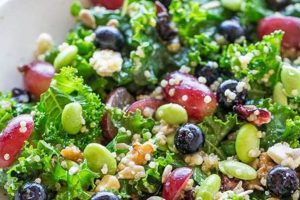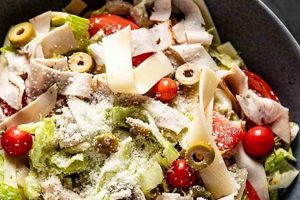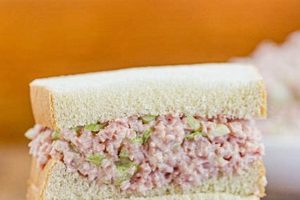Salads rich in dietary fiber offer a nutrient-dense meal option. For example, a combination of leafy greens, legumes, and various vegetables with a light dressing can provide substantial fiber. Such meals contrast with salads featuring primarily iceberg lettuce and creamy dressings, which offer minimal fiber content.
Consuming adequate fiber supports digestive health, promotes satiety, and contributes to healthy blood sugar regulation. Historically, human diets have been naturally higher in fiber due to a reliance on whole grains, fruits, and vegetables. Modern dietary shifts towards processed foods have led to a decreased fiber intake in many populations, emphasizing the importance of consciously incorporating fiber-rich foods like salads into one’s diet.
The following sections will delve into specific ingredients and preparation methods for creating flavorful, fiber-packed salads, addressing various dietary needs and preferences.
Tips for Crafting Fiber-Rich Salads
Creating salads that are both delicious and high in fiber involves strategic ingredient selection and thoughtful preparation. The following tips offer guidance on maximizing fiber content while maintaining palatability.
Tip 1: Prioritize Leafy Greens with High Fiber Content. Opt for spinach, kale, romaine lettuce, or mixed greens instead of iceberg lettuce, as these options offer significantly more fiber per serving.
Tip 2: Incorporate a Variety of Colorful Vegetables. Chopped bell peppers, carrots, cucumbers, broccoli, and shredded Brussels sprouts contribute both fiber and essential vitamins.
Tip 3: Add Legumes for a Fiber Boost. Chickpeas, lentils, black beans, or kidney beans are excellent sources of both fiber and plant-based protein.
Tip 4: Include Whole Grains for Added Texture and Nutrients. Quinoa, barley, or farro can enhance a salad’s fiber profile and provide sustained energy.
Tip 5: Choose Fiber-Rich Fruits Strategically. Berries, apples, and pears contribute fiber and natural sweetness. Dried fruits, such as cranberries or raisins, can also be added, but should be used sparingly due to their higher sugar content.
Tip 6: Enhance Flavor and Fiber with Nuts and Seeds. A sprinkle of chia seeds, flaxseeds, sunflower seeds, almonds, or walnuts delivers healthy fats, protein, and additional fiber.
Tip 7: Opt for Light and Flavorful Dressings. Vinegar-based dressings or a simple drizzle of olive oil and lemon juice are healthier alternatives to creamy dressings, which are often high in saturated fat and low in fiber.
By following these tips, individuals can create salads that are not only nutritious and satisfying but also contribute to long-term health benefits associated with adequate fiber intake.
In conclusion, thoughtfully composed salads can be a cornerstone of a healthy diet, promoting well-being through their rich fiber content and diverse nutrient profile.
1. Ingredient Selection
Ingredient selection is paramount in crafting a truly high-fiber salad. The choices made directly impact the nutritional value and overall health benefits derived from the meal. Careful consideration of various food groups ensures a balanced and effective contribution to dietary fiber intake.
- Leafy Greens: Foundation of Fiber
Leafy greens form the base of most salads and offer a substantial opportunity to boost fiber content. Spinach, kale, and romaine lettuce are excellent choices, providing significantly more fiber than iceberg lettuce. For instance, one cup of raw spinach contains approximately 1 gram of fiber, while the same amount of iceberg lettuce offers less than half a gram. Selecting nutrient-dense greens establishes a strong foundation for a fiber-rich meal.
- Non-Starchy Vegetables: Adding Diversity
Incorporating a variety of non-starchy vegetables expands the nutritional profile and fiber content. Carrots, bell peppers, cucumbers, and broccoli contribute not only fiber but also vitamins, minerals, and antioxidants. Chopped bell peppers, for example, provide around 2 grams of fiber per cup, enhancing both the texture and nutritional value of the salad.
- Legumes and Pulses: Fiber Powerhouses
Legumes, such as chickpeas, lentils, and black beans, are exceptional sources of dietary fiber. One cup of cooked lentils, for example, delivers a remarkable 15 grams of fiber. Their inclusion significantly elevates the overall fiber content of a salad, promoting satiety and digestive health.
- Seeds and Nuts: Concentrated Fiber and Nutrients
Seeds like chia, flax, and sunflower, along with nuts like almonds and walnuts, contribute both fiber and healthy fats. A tablespoon of chia seeds provides approximately 5 grams of fiber. These additions offer a concentrated dose of nutrients and further enhance the salad’s fiber profile.
Strategic ingredient selection, encompassing a variety of fiber-rich components from different food groups, is essential for maximizing the health benefits of a salad. By thoughtfully combining these elements, individuals can create meals that are not only delicious but also contribute significantly to their daily fiber intake, supporting digestive health and overall well-being.
2. Fiber Diversity
Fiber diversity, the inclusion of various types of dietary fiber, plays a crucial role in maximizing the health benefits of high-fiber salads. Different fiber types interact uniquely with the digestive system, impacting gut health, nutrient absorption, and overall well-being. Understanding these distinctions allows for the creation of salads that not only meet fiber intake recommendations but also optimize digestive function and contribute to long-term health.
- Soluble Fiber: Promoting Gut Health
Soluble fiber dissolves in water, forming a gel-like substance in the digestive tract. This viscous substance slows digestion, promoting satiety and contributing to healthy blood sugar regulation. Sources like oats, beans, apples, and citrus fruits offer soluble fiber. Incorporating these ingredients into a salad contributes to a balanced fiber profile and supports a healthy gut microbiome by providing nourishment for beneficial bacteria.
- Insoluble Fiber: Supporting Regularity
Insoluble fiber does not dissolve in water and adds bulk to the stool, promoting regular bowel movements and preventing constipation. Ingredients such as whole grains, nuts, seeds, and the skins of fruits and vegetables are excellent sources of insoluble fiber. Including these components in a salad ensures digestive regularity and contributes to a healthy digestive tract.
- Resistant Starch: Nourishing the Gut Microbiome
Resistant starch acts similarly to soluble fiber, resisting digestion in the small intestine and reaching the colon where it ferments, providing nourishment for beneficial gut bacteria. Sources of resistant starch include cooked and cooled potatoes, green bananas, and legumes. Adding these components to a high-fiber salad further supports a healthy gut microbiome and overall digestive health.
- Prebiotic Fiber: Selective Nourishment for Gut Bacteria
Prebiotic fibers are a specific type of soluble fiber that selectively nourishes beneficial bacteria in the gut. These fibers, found in foods like onions, garlic, leeks, and bananas, promote the growth of specific bacterial strains associated with improved digestive health and immune function. Incorporating prebiotic-rich ingredients into salads further enhances their positive impact on the gut microbiome.
Incorporating a variety of fiber sources in a salad, encompassing both soluble and insoluble types, along with resistant starch and prebiotic fibers, is essential for maximizing the health benefits. This diversity supports a balanced gut microbiome, improves digestion, and contributes to overall well-being. A well-composed high-fiber salad, therefore, should not only focus on quantity but also prioritize the diversity of fiber sources to optimize its nutritional impact.
3. Preparation Methods
Preparation methods significantly influence the nutritional value and palatability of high-fiber salads. While ingredient selection lays the foundation for a fiber-rich meal, proper preparation techniques maximize nutrient availability and enhance the overall dining experience. The following facets highlight the importance of careful preparation in creating salads that are both healthy and enjoyable.
- Chopping and Slicing Techniques
The way vegetables are chopped or sliced affects their texture, surface area, and even nutrient release. Smaller pieces increase surface area, potentially enhancing the release of certain vitamins and minerals during digestion. Uniformly chopped ingredients also contribute to a more aesthetically pleasing presentation and even distribution of flavors throughout the salad. For example, finely chopping kale can make it more palatable compared to large, tough leaves, encouraging greater consumption of this nutrient-rich green.
- Washing and Storage Practices
Proper washing removes potential contaminants, while appropriate storage maintains the freshness and nutritional integrity of salad ingredients. Leafy greens should be thoroughly washed and dried before storage to prevent wilting and bacterial growth. Storing chopped vegetables in airtight containers helps preserve their nutrients and extends their shelf life. These practices contribute to both the safety and nutritional value of the final salad.
- Cooking Methods for Certain Ingredients
Some ingredients, like grains and legumes, typically require cooking before inclusion in a salad. Proper cooking methods ensure optimal texture and digestibility. Overcooking can diminish nutrient content, while undercooking can make certain foods difficult to digest. For example, lentils should be cooked until tender but not mushy to maximize their nutritional contribution to the salad.
- Order of Addition and Dressing Application
The order in which ingredients are added and dressed can impact the final salad’s quality. Delicate greens should be added last to prevent them from wilting. Dressing should be applied just before serving to maintain the crispness of the vegetables and prevent the salad from becoming soggy. This attention to detail ensures a more enjoyable and palatable meal.
Consideration of these preparation methods elevates a high-fiber salad from a simple mix of ingredients to a carefully constructed dish that maximizes both nutritional value and culinary appeal. By implementing these techniques, individuals can create salads that not only contribute to their dietary fiber intake but also offer a satisfying and enjoyable dining experience.
4. Portion Control
Portion control plays a significant role in the effectiveness of high-fiber salad recipes for weight management and overall health. While high-fiber foods offer numerous benefits, consuming excessive quantities, even of healthy options, can hinder progress toward health goals. Understanding portion sizes and their impact on calorie intake is crucial for maximizing the benefits of fiber-rich salads.
- Calorie Awareness
Even with nutrient-dense, high-fiber salads, calorie intake must be considered. While fiber contributes to satiety, excessive portions can still lead to a calorie surplus. Understanding the caloric density of various salad ingredients, such as nuts, seeds, and certain dressings, allows for informed portioning to align with individual caloric needs. For example, a salad overloaded with calorie-dense toppings can negate the intended health benefits.
- Balancing Macronutrients
Portion control facilitates balanced macronutrient intake within a high-fiber salad. While fiber is essential, adequate protein and healthy fats are also necessary for optimal health. Proper portioning ensures that the salad provides a balanced combination of these macronutrients, supporting satiety and overall nutritional needs. A large salad heavily focused on leafy greens might lack sufficient protein or healthy fats, potentially leading to hunger and nutrient deficiencies.
- Digestive Tolerance
Individual digestive tolerance to high-fiber foods varies. Consuming excessively large portions of high-fiber salads, especially when increasing fiber intake rapidly, can lead to digestive discomfort, such as bloating and gas. Gradual increases in fiber intake and mindful portioning allow the digestive system to adapt, minimizing potential discomfort and maximizing the benefits of fiber consumption.
- Meal Planning and Satiety
Portion control within high-fiber salads plays a crucial role in meal planning and achieving satiety. Understanding appropriate portion sizes allows individuals to effectively incorporate these salads into a balanced meal plan. Properly portioned salads, combined with other nutrient-rich foods, contribute to sustained satiety, reducing the likelihood of overeating and supporting weight management goals.
Integrating portion control into the consumption of high-fiber salads ensures these meals contribute effectively to health goals. Mindful portioning maximizes the benefits of fiber while managing calorie intake, balancing macronutrients, and promoting digestive comfort. By considering these factors, individuals can leverage the nutritional power of high-fiber salads to support their overall health and well-being.
5. Dressing Choices
Dressing choices significantly impact the nutritional profile and overall health benefits of a high-fiber salad. While the foundation of such a salad lies in fiber-rich ingredients, the dressing can either complement or detract from these benefits. A poorly chosen dressing, often laden with added sugars, unhealthy fats, and excessive sodium, can negate the positive attributes of a carefully constructed, fiber-rich meal. Conversely, a well-selected dressing enhances flavor, provides beneficial nutrients, and supports the salad’s health-promoting properties. For example, a creamy ranch dressing, while palatable, can contribute significant saturated fat and calories, overshadowing the fiber content of the salad. In contrast, a vinaigrette made with olive oil and vinegar offers healthy fats and antioxidants, complementing the fiber-rich ingredients.
The interplay between dressing choices and the efficacy of a high-fiber salad recipe centers on maintaining a balance between flavor and nutritional value. Dressings should enhance, not mask, the natural flavors of the salad’s components. Furthermore, they should contribute to, rather than compromise, the health benefits associated with high-fiber intake. This balance can be achieved by prioritizing dressings made with whole, unprocessed ingredients. Olive oil, vinegar, lemon juice, herbs, and spices offer flavor complexity without the detrimental effects of processed dressings. Consider a salad featuring chickpeas, quinoa, and mixed greens. A tahini-based dressing complements the earthy flavors while contributing healthy fats and additional fiber. This approach exemplifies a synergistic relationship between dressing and salad, optimizing both flavor and nutritional value.
Strategic dressing selection is therefore integral to a successful high-fiber salad recipe. Prioritizing dressings that complement the salad’s nutritional goals ensures that the final dish contributes effectively to a healthy diet. This awareness empowers individuals to make informed choices that support both palatability and nutritional well-being. The interplay between dressing and salad ingredients underscores the importance of considering all components of a meal when striving for optimal health outcomes.
6. Digestive Health
Digestive health significantly benefits from the regular consumption of high-fiber salads. Fiber, a non-digestible carbohydrate, plays a crucial role in maintaining optimal gastrointestinal function. Within high-fiber salads, this is achieved through several mechanisms. Fiber adds bulk to the stool, promoting regularity and preventing constipation. It also nourishes beneficial gut bacteria, contributing to a balanced gut microbiome. This balanced microbiome plays a vital role in nutrient absorption, immune function, and overall well-being. A diet lacking in fiber can lead to digestive issues such as constipation, diverticulosis, and irritable bowel syndrome. For instance, individuals consuming a diet rich in processed foods, which are typically low in fiber, often experience irregular bowel movements and digestive discomfort. Conversely, those who regularly consume high-fiber salads, rich in ingredients like leafy greens, legumes, and whole grains, often report improved digestive regularity and reduced instances of constipation.
The practical significance of understanding this connection lies in the ability to leverage high-fiber salad recipes to address specific digestive health concerns. For individuals experiencing chronic constipation, incorporating salads with a variety of fiber sources can provide significant relief. The diverse fiber types found in these salads soluble, insoluble, and resistant starch work synergistically to promote optimal bowel function. Soluble fiber, found in ingredients like apples and beans, forms a gel-like substance that softens the stool. Insoluble fiber, found in ingredients like whole grains and the skins of vegetables, adds bulk to the stool, promoting movement through the digestive tract. Resistant starch, found in cooked and cooled potatoes and legumes, acts as a prebiotic, nourishing beneficial gut bacteria. This multifaceted approach to fiber intake supports a healthy and efficient digestive system.
In conclusion, the link between digestive health and high-fiber salad recipes is undeniable. Fibers role in promoting regularity, nourishing the gut microbiome, and preventing digestive disorders underscores the importance of incorporating these salads into a balanced diet. Addressing digestive health challenges through dietary modifications, such as increasing fiber intake through salads, offers a natural and effective approach to improving overall well-being. This proactive approach not only alleviates existing digestive issues but also contributes to long-term digestive health and reduces the risk of developing chronic digestive diseases.
Frequently Asked Questions
This section addresses common inquiries regarding high-fiber salad recipes, providing clear and concise information to facilitate informed dietary choices.
Question 1: How much fiber should one aim for in a high-fiber salad?
A high-fiber salad ideally contains at least 5-10 grams of fiber per serving. This amount contributes significantly to the recommended daily fiber intake, which is approximately 25-30 grams.
Question 2: Can high-fiber salads aid in weight management?
Fiber promotes satiety, potentially reducing overall calorie intake. High-fiber salads, especially when combined with lean protein and healthy fats, can contribute to weight management efforts by promoting fullness and reducing the likelihood of overeating.
Question 3: What are some suitable salad dressings for a high-fiber diet?
Vinaigrettes made with olive oil and vinegar, lemon juice, or tahini offer healthy fats and complementary flavors without excessive calories or unhealthy additives. Avoid creamy dressings, which are often high in saturated fat and low in nutritional value.
Question 4: Are there potential side effects of consuming too much fiber?
Rapidly increasing fiber intake can sometimes lead to temporary digestive discomfort, such as bloating and gas. Gradually increasing fiber intake and ensuring adequate hydration minimizes these potential side effects.
Question 5: How can variety be incorporated into high-fiber salads?
Utilizing a wide range of leafy greens, vegetables, legumes, nuts, seeds, and even fruits ensures diverse nutrient intake and prevents monotony. Experimenting with various flavor combinations enhances palatability and encourages consistent consumption.
Question 6: Can high-fiber salads be suitable for individuals with specific dietary restrictions?
High-fiber salads can be adapted to accommodate various dietary restrictions. Gluten-free grains like quinoa or brown rice can be substituted for wheat-based options. Vegan diets benefit from the inclusion of plant-based protein sources such as legumes and tofu.
Understanding the principles outlined above enables individuals to effectively incorporate high-fiber salads into a balanced and healthful dietary regimen.
For further information on specific salad recipes and meal planning strategies, consult the following resources…
High-Fiber Salad Recipes
Exploration of high-fiber salad recipes reveals their significant potential in promoting health and well-being. Strategic ingredient selection, incorporating diverse fiber sources such as leafy greens, legumes, and whole grains, forms the foundation of these nutritionally robust meals. Careful attention to preparation methods, portion control, and dressing choices further optimizes the health benefits and culinary appeal. Understanding the interplay between fiber diversity, digestive health, and overall wellness underscores the value of incorporating these recipes into a balanced dietary pattern.
Prioritizing high-fiber salad recipes represents a proactive approach to disease prevention and health management. The potential to positively influence digestive health, weight management, and blood sugar regulation warrants further exploration and integration of these versatile meals into dietary practices. Continued research into the multifaceted benefits of fiber-rich diets promises to further illuminate their role in achieving optimal health outcomes.






